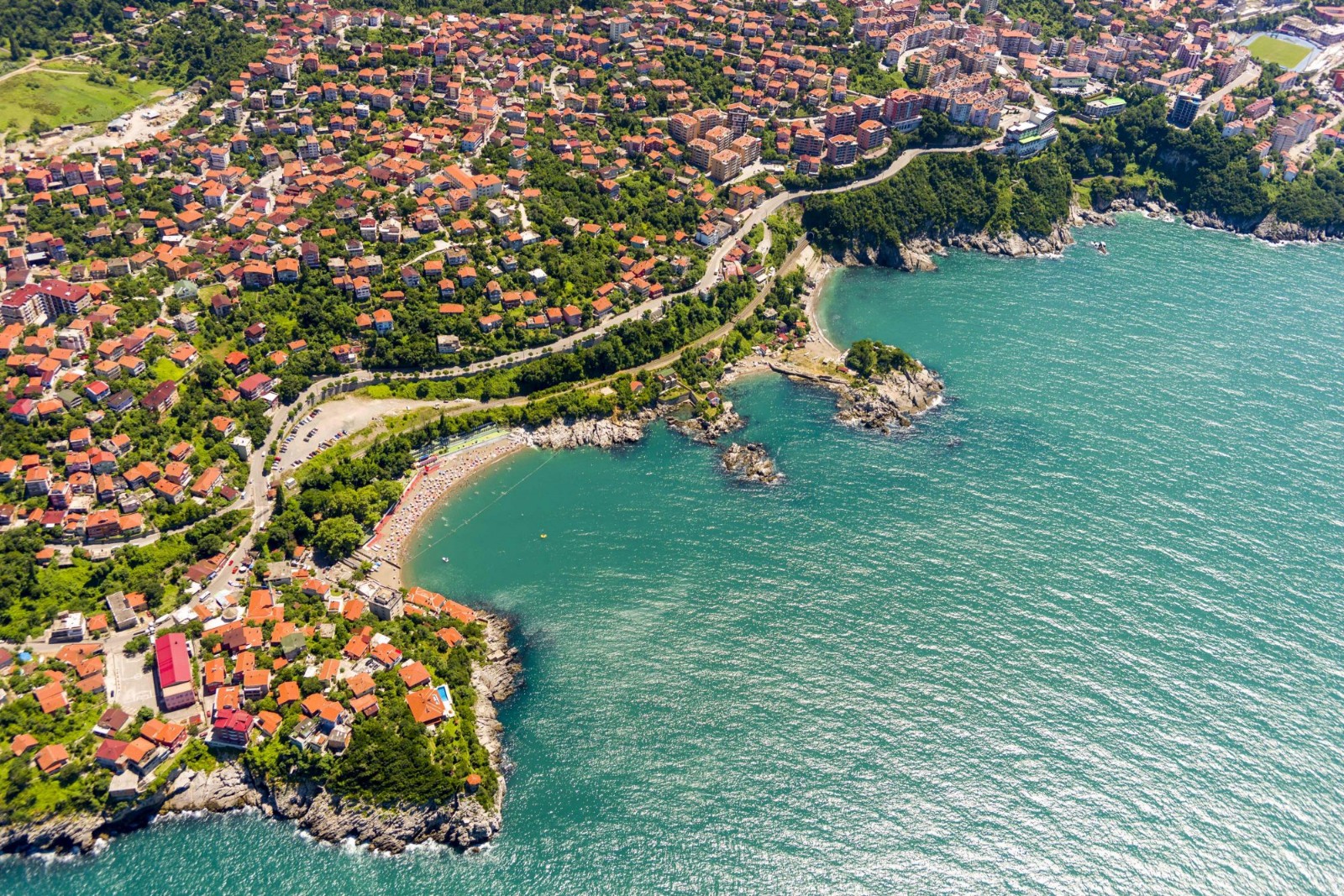Filyos Beach
It is located in Filyos town of Çaycuma District of Zonguldak. To the west of Filyos Creek, there is a very large sandy area. At Filyos Beach, it is possible to enter the sea from Abacık locality to the castle. The beach is located on both sides of the harbour, the beach is about 2 kilometers long. A hotel is available in the vicinity. The beach where Yesil Meets Blue is decorated with historical ruins of the ancient city of Tios. The theatre, Aqueduct and castle belonging to the ancient city of Tios are important tourist areas.

Sürek Adventure Trail
Sürek Creek is one of the tributaries that feeds Ahmetler Creek, which flows into Filyos Creek just south of the district center of Gökçebey. At the confluence of sürek Creek with Ahmetler Creek, it is also the entry point of Sürek Canyon and the Valley/Canyon through which it flows. There are shawls large and small. It offers many activity opportunities to nature and adventure-loving visitors.

Tios-Tieion ancient city and Filyos Castle
Çaycuma district is located in the resort of Filyos. Filyos, III BC. it is a colony of Miletus established for commercial purposes in the century. The city is known as an important Trade Center where goods brought from the north of the Black Sea are unloaded in ancient times. There are ruins such as Castle, Open-Air Theatre, underground city, aqueducts, ancient harbour mend in the town where Roman, Byzantine and Genoese ruled in various periods. HistoryHe. The ”ancient city of Tios – Tieion”, dating back to 1200, is still waiting to be unearthed by an ongoing archaeological excavation.
Filyos Castle, believed to have been built by the Romans, was built on a promontory that dominates the sea of the city. Large stones were used in its construction in order to give it a strong and imposing appearance. The first settlement was on Castle Hill in the north of the city. Today, here are the walls of the medieval castle and the ruins of the tower dating back to the Hellenistic-Roman periods. Marble columns and pedestals, marble inscribed plates, stone sarcophagi and brick tombs were unearthed to the east of the Castle Hill.

Harmankaya Canyon and waterfalls
Harmankaya Canyon is an extremely unique natural wonder that attracts attention with its proximity to the city center of Zonguldak. A path in the forest descends into the valley where the waterfalls are located. Despite the current challenging geography of the area, it offers alternatives that allow it to host a large number of nature enthusiasts. Along the trail visitors are accompanied by lush vegetation.
Waterfalls are 12 kilometers from the city center of Zonguldak. It is reached by a 3-kilometer walk on the river bed. It is between 250-280 meters altitude and was caused by eroding the clay decays of Karagöl Creek.

Gökgöl Cave
Gökgöl cave is the tenth longest cave in Turkey with a total length of 3,350 meters and the second longest cave in Zonguldak. In the cave, which has an 875-meter walkway, an underground stream flows, whose flow increases during rainy periods. The interior of Gökgöl cave is extremely rich in terms of drop stone accumulation. Parts of the cave from the entrance to the Great Depression Hall are described by names such as fossil entrance, asthma Hall, Hall of Wonders and Hall of Miracles. As can be seen from the Hall names, there are all kinds of formations in the cave. Stalactites, stalagmites, stalactites and stalagmites, as well as flag drop stones and dense pasta stalactites located on the stream, are worth seeing. Gökgöl cave has microclimate properties due to the fact that temperature and humidity do not change much during the year. Because of this feature of the cave, it is also used in the treatment of patients with respiratory tract (asthma), and the cave is of great importance in terms of health tourism.
Gökgöl Cave opened to tourism in 2001; the concept of the formation of the different lighting, disabled-friendly walkways, glass bridges, terraces and souvenir outlets recently completed visitor center, restrooms, and parking lots, as well as the Ankara-Zonguldak industrial and geological heritage items located at the edge of the highway with significant tourism potential in terms of Tourism hosts the advantage of being close to the city centre to Zonguldak strong value.

Karaelmas Mine Martyrs Museum
Karaelmas mine Martyrs Museum, where the process of founding the Turkish Stone Foundation is explained, the objects of the mine workers and many documents belonging to various periods are displayed, takes its visitors on a journey in the mining history of the city.

Zonguldak Mining Museum
The museum building located in the center of Zonguldak consists of foyer, exhibition halls, meeting rooms, warehouses and administrative unit rooms. The Coal - City relationship is discussed in the foyer area. After 10 minutes of Zonguldak promotion in the promotion room, visitors who are taken to the exhibition hall are given historical and technical information about coal mining in Zonguldak. Materials and educational books related to occupational safety, topography, health, social care are exhibited in the second floor storefronts. Coke derivatives of third layer coal, fossils and formation of coal are described. Besides, there is a TTC training January right next to it.

Kapuz Beach
Kapuz Beach is one of the 7 Blue Flag beaches in the Black Sea, as well as the only Blue Flag beach in Zonguldak. Kapuz Beach, located in the center of Zonguldak city, has a length of 180 meters and a width of 25 meters. Kapuz Beach is a public beach operated by Zonguldak Municipality. The Yesil beach, where green and Blue meet, has a sand beach. The trees at the back of the beach comfort people with their shadows.

Fener quarter and Varagel tunnel
The city of Zonguldak expresses a developing identity on coal-labor. Zonguldak is a neighborhood located in the northeast part of the city center on the promontory that extends to the Black Sea. Boasting 1893/1896 coal production in the region in January, as on the determination mahal built by the French company ‘French Quarter’; nose 1908 Lighthouse (Lighthouse Zonguldak) after ‘Lantern Quarter known as’; although the name of the region, the official records of geographic inspired by nature ‘Plateau Neighbourhood’ have been registered as.
Yayla Mahallesi, a different settlement with its natural structure, historical background and cultural characteristics, is a region of Zonguldak that should be preserved on the scale of the neighborhood and transported to the future. The neighborhood has been declared an urban site.
This tunnel, which was made for industrial use, was built into the Rocky, which has karst structural features, by the sea. This feature contributes to the natural heritage. Because it is a value used in industry, it contributes to cultural industrial heritage. Since it has a history of about seventy-five years, it has historical characteristics. 3 it contributes to tourism in terms of its inclusion in the context and providing opportunities for types of Tourism.

Gümeli Natural Monument and Memorial Yew Tree
Alapli District in the Gumeli forests, due to the natural resource values it carries, the area of 2550 decares was declared as a Gumeli Natural Monument on March 11, 2008. The most important feature of the site is that of course, there are yew trees aged 1987 and 1164. There are a large number of yew trees in the area, with an average age of between 300 and 500 decks.The most important feature of Gümeli Natural Monument is its unique natural features, which allow a tree to live like a young seedling for thousands of years. With these characteristics, Gümeli Natural Monument is one of the most sensitive and valuable of Turkey's rich natural tourism areas.
Yew Tree, which is the oldest tree in Turkey and one of the 5 oldest trees known in the world, is located in Gümeli town of Alaplı District of Zonguldak. It was discovered in 2016 and was determined to be 4112 years old when it was discovered. Upon its discovery it was designated and registered as the oldest known Yew Tree in the world.

Caverns Of Hell
It is the common name of 3 side-by-side caves located in Ereğli, 50 km from the provincial center. These caves developed in volcanoclastic rocks. Two of the caves have Lakes.
The first cave consists of 2 parts. On the floor of the first part there is a mosaic decorated with plant and geometric motifs.
The second cave is about 10 m high on the side of the road and is called Koca Yusuf cave on the side of the local people.
The third cave is the widest in terms of area. Its floor is covered with floor water. The cave, which was made with a human hand, served as a water cistern for the first and second caves. The Caverns of hell have features such as being both an important prophetic center of the first age and a place of worship of the first Christianity.

Alemdar Ship Museum
She is the unarmed rescue ship of the Alemdar ship's only naval skirmish in the war of Independence. It was rebuilt in the same dimensions and turned into a museum. Alemdar ship carried the weapons and ammunition needed by the army to Trabzon and Inebolu. A large number of local and foreign tourists visit the museum, where there are meterials describing all these services.
Amasra, the pupil of the world with its magnificent nature, history and gastronomy values
Amasra, the pupil of the world with its magnificent nature, history and gastronomy values
Amasra, the district of Bartin, the Pearl of the western Black Sea, is at least as prominent as Bartin. The biggest reason for this is based on the deep-rooted past it has. Amasra is an important destination with its history, nature, sea and cultural richness that fascinates those who travel and see it. M.He. 12. it was founded by the Phoenicians in the 13th century. it was captured by the Genoese in the century. Amasra got its name from M.He. 3. it is named after Queen Amastris, who ruled this town in the century. For Amasra, one of the first places of tourism in Turkey, Fatih Sultan Mehmet Khan said the word “Lala Lala Çeşm-i Cihan bu mu ola”, that is, “this is the pupil of the world”. Amasra offers visitors a visual feast with its unique landscape besides its historical and natural beauties. Amasra also offers an important feast to those who come with fresh and delicious fish and Amasra salad.

Güzelcehisar, Home To 80 Million-Year-Old Lava Columns
Located in the Güzelcehisar region of Bartin, the pentagonal and hexagonal lava columns formed in exceptional beauty dating back to 80 million years ago are a unique natural and geological heritage left to Bartin millions of years ago. Güzelcehisar is one of the Paradise corners of our country, which fascinates those who see it with its green surroundings, wonderful sea, sand and insatiable sunset on the Black Sea coast. The feature that distinguishes güzelcehisar from its counterparts and places it in the front row is not only its natural beauty, but also the lava columns that are located here and are a natural wonder. Walking on the unique sands of güzelcehisar, the geometric cross-section basalt columns, which start at the western end of the Long Beach and rise like a wall from the sea, extend along the Sea coast from Güzelcehisar to Mugada Bay, another natural wonder. In 2017, Bartin-Güzelcehisar basalt columns were declared as natural monument.

Bartın River, Named After Parthenius, Meaning “City Of Waters” In Ancient Times
The most important river of Bartin, m.He. It is the Bartın River, which is named after Parthenios and gives its name to the city. Kocachay and Kocanazçay, which form the two main tributaries of the Bartın River, merge at the Gazhane Cape in the center of Bartın and reach the Black Sea at the Bosphorus location by traveling 14 km. It is an important tourism focus that also allows transportation on the Bartın River. Due to the low flow rate of the river reaching the Black Sea, boat tours are available. Areas around the river that are suitable for activities such as angling, photography, hiking, recreation and eating and drinking are also available.

Natural Wonder Yedigöller National Park
The National park, which was protected in 1965 and contains a large number of plant species, has the most beautiful natural forests in Turkey. It is a nature paradise with a variety of animals ranging from wild animals such as bears, pigs, Wolves to over a hundred species of birds. It provides opportunities for activities such as picnicking, recreation and sports with various land forms and walking paths.

Natural Museum Küre Mountains National Park
Strabo, considered one of the first geographers in history, wrote 2000 years ago in his book Geographika, noting that the best breed of boxwood tree grows on the territory of Amatrice (Amasra), mentioned the sphere Mountains National Park and its surroundings. Evliya Çelebi also described the forests in Amasra region in his work Seyehatnama; that is, the sphere Mountains National Park region as a tree stream.
Küre Mountains National Park, which has the best wild examples of the endangered ‘Black Sea moist karst forest’ ecosystems today, is one of the ‘100 forest hot spots’ that should be protected in Europe. A hot spot is a term conservationists use to describe areas around the world that have a high level of endemism (the presence of a plant species confined in a narrow area), as well as rapidly losing habitat. Küre mountains have an important ecotourism potential with its rich flora and fauna alongside its streams, canyons, caves and springs.

The Tunnel Of Trees That The Beholders Admire
Tree tunnel the road in the direction of Bartin-Safranbolu is one of the famous points. As a result of the merging of roadside trees into the sky, an image of a tunnel is formed. It is an area that reveals unique views on the Bartin - Karabük road, which is used by tourists coming from Safranbolu District of Karabük to Amasra District of Bartin. Bahçecik and Ovacuma villages in the area of the right and left trees block the road, the landscape, almost fascinates those who see. The 9km road, where branches of trees cover the sky, has been declared a ‘special area to be protected’. Passers-by are advised to take pictures with the stunning scenery.










